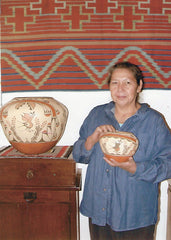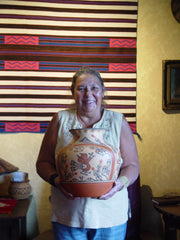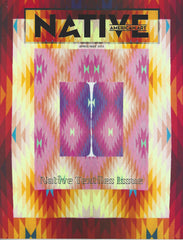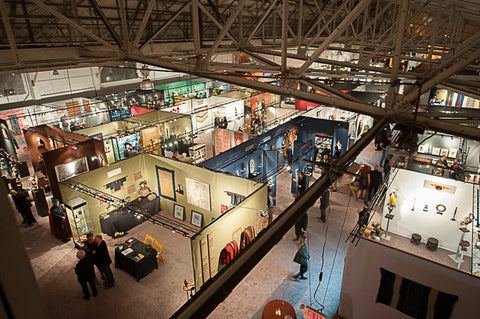Nizhoni Ranch News

A spotlight on Zia Potter Ruby Panana
 Ruby Panana has been a creating stunning pottery since 1983. Her pottery began winning awards from the very first time it was exhibited. Ruby's work encompasses many forms from jars, bowls, vases, wedding vases and even canteens. She produces some of the largest Zia pottery pieces. Her works of art are painted with natural materials - clay, rocks, sand, and she creates black from wild spinach. Her brushes are created traditionally by chewing yucca to create the perfect tool.
Ruby Panana has been a creating stunning pottery since 1983. Her pottery began winning awards from the very first time it was exhibited. Ruby's work encompasses many forms from jars, bowls, vases, wedding vases and even canteens. She produces some of the largest Zia pottery pieces. Her works of art are painted with natural materials - clay, rocks, sand, and she creates black from wild spinach. Her brushes are created traditionally by chewing yucca to create the perfect tool. Ruby's gorgeous works are on exhibit in noted Southwest galleries: The Indian Craft Shop, the Museum of Northern Arizona, and the US Department of the Interior in Washington DC. You can find her pottery in major collections, including the Wright Museum at Harvard.
 Steve and I wanted to share with you the beautiful works of the Zia Potter, Ruby Panana. We are prompted by the latest edition of the Native American Art Magazine, which is featuring POTTERY. Ruby is a wonderful person and works very hard to bring to life the clay she coils. We hope you will enjoy the selection below and possibly find one or two, that will fit into your collection.
Steve and I wanted to share with you the beautiful works of the Zia Potter, Ruby Panana. We are prompted by the latest edition of the Native American Art Magazine, which is featuring POTTERY. Ruby is a wonderful person and works very hard to bring to life the clay she coils. We hope you will enjoy the selection below and possibly find one or two, that will fit into your collection.We are always just an email or phone call away.
Always happy to answer questions.

E steve@navajorug.com
P 520-455-5020
- DeAnne Clifton
- Tags: News

Generations of Love
In 1982 we took a photo of Evelyn Yazzie holding a completed weaving. At her side was her granddaughter (holding a smaller weaving of her own) and our son, Sean, who was only 5 at the time.
Steve noticed the similarity in the corner design of the two Navajo Sandpainting Rugs, that previously hadn't hung near each other in the gallery. He then remembered Evelyn's special corner design and pulled that photo from our archives .

The weavings that brought us to this search were important Navajo Sandpainting Textiles that were being displayed for our "Woven Holy People" exhibit last fall. Look at the corners... do you see? They are the same.
The photo we found confirmed our suspicions. Steve remembered that Evelyn told her this corner design had been passed down to her from her mother, and to her mother from her grandmother. She had told us that this was a family design and wasn't shared with other weavers. THAT meant that Evelyn had descended from the weavers who had woven the sandpainting textiles. According to Steve's research, the weaver was the daughter of Miguelito - a very important medicine man, her name was Altnabah.
Today, we received a comment on the original blog post of this story from Evelyn's granddaughter Malinda, the young girl holding her own weaving:
Steve that would be me in the photo, the youngest of Evelyn’s kids. One of my rugs my mom helped me with that I am holding. My mom would have been 92 this year. Miss her very much on this Mother’s Day. I will remember all the days of deadlines and your visits through all the summers of my childhood. Thank you for sharing this photo
We miss her very much too. She was a great friend for many, many years and was an incredibly gifted weaver. Her favorite weavings were the Ganado and Klagetoh style.
The love of a mother to a daughter, and a grandmother to a granddaughter is a bond that is rooted deeply. The generations of love that have shared the gift of weaving with the next, is a blessing to all who have the opportunity to see and appreciate their talent.
Stop by our Master Weavers page to appreciate the Women who have shared their weaving talents.
This Mother's Day, think back to the special women in your family who have shared traditions with you.
Happy Mothers Day
- DeAnne Clifton

Hogans - The Center of the Navajo World

The ancient hogan, known as the "forked stick hogan" was a conical hut constructed of three forked poles covered with logs, brush and mud. Called the "male" hogan by the Navajos, examples of this swelling can still occasionally be found in the western part of the reservation. More common today is the "female" hogan, a circular or 6 sided dwelling constructed of logs or stone, with a doorway facing east and a smoke hole in the center of the roof.

The dome-shaped roof is formed of cribbed logs covered with dirt. The fire is placed on the hard-packed floor beneath the smoke hole and a flap or hinged door covers the doorway. Traditionally the hogan lacked windows and was ventilated by the smoke hole in the roof and the east-facing doorway. Nowadays not only do the hogans have windows but they may also contain stoves, chimneys, beds, and refrigerators and TVs,

Today white prototype houses and even mobile homes are common on the reservation, but families that live in such dwellings also construct a hogan nearby. Many of the People have retained their native religion and Navajo ceremonies can be conducted only in a hogan.

Most Navajo families own 2, 3, or several hogans and more than one permanent establishment if they own sheep. A family that owns several hundred sheep and other livestock might have as many as 5 or 6 separate clusters of buildings scattered over a large area as the animals must be moved from place to place at various seasons of the year.

Variations in the weather and the water supply may require that a family live in one place during the summer and another during the winter. Usually though, each family has one location which is their main residence at which there are more or less permanent corrals, storage dugouts, several hogans and temporary shades or bush hogans for summer use.
The Navajo hogan is more than just a place to eat and sleep and the concept of it as a "home" bears little resemblance to a white person's attitude toward his dwelling place. The hogan is a gift of the gods and as such it occupies a place in the sacred world. The first hogans were built by the Holy People of turquoise, white shell, jet, and abalone shell. The round hogan is symbolic of the sun and its door faces east so that the first thing that a Navajo family sees in the morning is the rising sun, Father Sun, one of the most revered of the Navajo deities. The construction of a new hogan is almost always a community affair. Once completed, the new hogan is consecrated with a Blessing Way ceremony whereby the Holy People are asked to "let this place be happy."
 Also nearby, but out of sight, will be at least one sweat hogan. The sweat hogan is small scale replica of the old-style forked stick hogan but without the smoke hole. It is constructed of three sticks with forked ends which are fasten together in a tripod. Two straight sticks are leaned against the apes from the east to make the sides of the door. It is heated by placing hot rocks within, the door being closed with several blankets. The sweat hogan provides excellent bathing and purifying facilities for the Navajos in their land of scarce water. As in virtually everything a Navajo does, there are prescribed rituals that must be followed in taking a sweat bath. Four verses of the Sweat Bath Song must be sung before a Navajo can leave the sweat hogan, which the Navajo call the Son of the She Dark, to plunge into cold water or dry himself in the sand.
Also nearby, but out of sight, will be at least one sweat hogan. The sweat hogan is small scale replica of the old-style forked stick hogan but without the smoke hole. It is constructed of three sticks with forked ends which are fasten together in a tripod. Two straight sticks are leaned against the apes from the east to make the sides of the door. It is heated by placing hot rocks within, the door being closed with several blankets. The sweat hogan provides excellent bathing and purifying facilities for the Navajos in their land of scarce water. As in virtually everything a Navajo does, there are prescribed rituals that must be followed in taking a sweat bath. Four verses of the Sweat Bath Song must be sung before a Navajo can leave the sweat hogan, which the Navajo call the Son of the She Dark, to plunge into cold water or dry himself in the sand.
On the edge of the hole where they come up,
He put down the Son of the She Dark.
He built it of valuable soft materials.
Everlasting and peaceful, he put it there.
He put it there."
--- A Verse of the Navajo Sweat Bath Song
The bather then reenters the sweat hogan and sings four more verses of the song. He repeats the ritual until the entire song has been sung. - Raymond Friday Locke
Traditional structured hogans are also considered pioneers of energy efficient homes. Using packed mud against the entire wood structure, the home was kept cool by natural air ventilation and water sprinkled on the dirt ground inside. During the winter, the fireplace kept the inside warm for a long period of time and well into the night.

The evolution of the Navajo Hogan, Left to right. The very old hogan. A later style, a few of which are still in use. The hogan of today, with log walls and dirt roof. Many Navajos live in modern log and stone houses, similar to the one pictured above. -- Southern Navajo Agency, 1933
----------------------
 Weavings which depict hogans and everyday life give us a timeless image of this traditional culture.
Weavings which depict hogans and everyday life give us a timeless image of this traditional culture.
Take a look at some of the Pictorial weavings that we have available. Click here.
- DeAnne Clifton

Native Weavings Featuring Mountainway Dancers
Native American Art • April / May 2017








We have typed the words to this article for easier reading. You can read it in full here.
- DeAnne Clifton
- Tags: Navajo Rug

Treasure at the End of the Rainbow!
"The end of the rainbow for Navajo rugs"
★★★★★ Reviewed by X-NYr on TripAdvisor.com
We visited Nizhoni today and were overwhelmed by the breadth of the Navajo rug collections, displayed in a fantastic ranch home, gorgeous setting, with fabulous Mission furniture and a knowledgeable and an enthusiastic couple who have amassed this extraordinary array of quality and creativity.
If you are looking for the very best of the best of Navajo weavings, this is the place. It's by appointment only, and it's in Sonoita about an hour south of Tucson. A friend recommended this gallery to us, and we are so delighted that we were able to visit.
The prices are high but commensurate with the quality, value and exceptional designs; both modern rugs and antiques. There were many innovative designs, based on classic patterns, that we have never seen anywhere else, including at the trading posts on the Navajo reservation.
They have many rugs that have won best in show at the Inter-tribal Ceremonial in Gallup. They have many smaller rugs but they seem to specialize in large size rugs.
If you are a serious collector - or want to start at the top - this is The place. The collection tops the Heard Museum and far exceeds what's displayed at the Indian Museum in Washington, DC. Yes, I sound carried away, but this was just the most amazing collection we've ever seen.
Reviews like this make our hearts soar! Thank you!![]()
ps. We'd love to show you around the gallery.
Call us at 520-455-5020 if you would like to schedule an appointment.
 |
| If you've visited our little place in the desert, we'd be honored if you would take a moment to share your experience with others on TripAdvisor. Just click the TripAdvisor owl to get started. |
- DeAnne Clifton

Native American Art Article: Modernist Weavings
Modernist Weavings
 The Native American Art Magazine published a great article about our new exhibition, Navajo Textiles as Modern Art - Then and Now
The Native American Art Magazine published a great article about our new exhibition, Navajo Textiles as Modern Art - Then and Now
You can read the full article and see photos and accompanying video here. Please do so, and enjoy! It's worth the read!
- DeAnne Clifton
- Tags: News

The Thrill of Twill
Twill weaving is one of the most difficult styles to master. Those who do create works of art. It's a dying art form.
While fewer and fewer artists are able to execute the twill weave, it’s important to remember that even the ones made long ago are still standing the test of time because of their strength and unique weaving technique. Unlike other patterns and weaving styles, the twill uses a four harness loom by replacing the standard pull shed and stick shed with a stick shed and three pull sheds, a weaving technique adapted from the Pueblos.
Take a look at some of the thrilling Twill beauties we have available:
 |
 |
Do you like surprises of the good kind? If so, that's exactly what this weaving is. It sure doesn't look like much in the overall photo, does it? BUT when you look at the detailed photos, you see the great surprise!
Look at the Diamond twill pattern of weaving. This style of weaving was passed to the Navajo via the manta designs of the Pueblo Indians. The work in this piece is just stunning and could only have been accomplished by the finest of artisans. And the quality is appreciated even more when you consider it was woven in the 1880s on an outdoors loom.
To appreciate this weaving in "living color" please watch our Facebook video describing it: http://bit.ly/nrg-pc66v
 |
 |
Woven entirely using the twill technique, this is an extremely rare masterpiece!
The skilled artisan used hand-carded, hand-spun, hand-dyed Merino wool, and used vegetal dye to obtain some of the coloring.
It's hard to believe that this woven art was brought to life on loom outside where the artist sat daily and played it's music to paint this incredible joyfully colored piece. It just sings to your soul, doesn't it?
 |
 |
This piece was created to be used as a double saddle blanket. The loom artist used a beautiful diamond twill design which gives beautiful depth and movement to the piece. Do you see the lighter bands? Those were made by taking red American flannel bolt of material and unraveling it. Then the long pieces of thread would be carded together to form thicker pieces of yarn. A feat of creative artistry in itself.
We have an excellent video on facebook in which Steve is describing this piece. You can watch it here: http://bit.ly/nrg-ght2252v
Do you have any Twill weavings? What is your favorite thing about them?
- DeAnne Clifton

Elsie Bia - This Woman - These Hands
Blessed by Spiderwoman to Create Art
Elsie Bia is an incredibly gifted Master Weaver. When we open a new exhibit at the ranch she will pack up her loom from the reservation, reassemble it here, and give the most fascinating weaving demonstrations for all who come to the Open House on March 11th for the Navajo Textiles as Modern Art exhibit.

It was mesmerizing we watched her complete this incredible piece. It's one of the most difficult parts of weaving and we were honored that she chose to share it with our guests. Each piece of art that she weaves is of the highest quality. Elsie LOVES to weave, and it's clearly evident. Learn more about this weaver gifted by Spiderwoman and shop her weavings. Click here.
 There are four short videos of Elsie with this piece that you can watch on our Facebook page. We also have videos where Steve talks about individual weavings from this exhibit.
There are four short videos of Elsie with this piece that you can watch on our Facebook page. We also have videos where Steve talks about individual weavings from this exhibit.
Daylight Saving Time
 Fun trivia fact: Arizona, Hawaii, and our overseas territories do NOT observe Daylight Saving Time.
Fun trivia fact: Arizona, Hawaii, and our overseas territories do NOT observe Daylight Saving Time.
However, the Navajo DO observe Daylight Saving Time on tribal lands!
Come! Be our Guest ...

We had a full gallery as folks came for the Navajo Textiles as Modern Art exhibit opening and more than 60 weavings spanning a period of over 130 years were on display.
If you couldn't make it, contact us for a personal tour! The exhibit runs until June 30th.
Phone: 520-455-5020
Email: steve@navajorug.com
- DeAnne Clifton

Navajo Textiles as Modern Art Opens Mar 11
From weaving a blanket or rug for practical and personal need to creating weavings for the trade market and as a source of income, the perception of Modern Art Design in Navajo textiles has evolved over time.

Navajo Textiles Modern Art is an exhibition of over 60 Navajo Textiles spanning 137 years from the 1880s to the present. This exhibit will be on view at Nizhoni Ranch Gallery from March 11 - June 30th.
These special textiles, rugs, and weavings will demonstrate how Modern Art in the eye of the weaver has changed over the years.

"Our inspiration for this show is really to share important Navajo Art with the public. Today Modern Art is all over the map - we want to share these designs with those who may not have ever been exposed to them before."
As always, our gallery is open for you. Contact us to schedule an appointment. We look forward to sharing this delightful exhibit with you.

Navajo Textiles as Modern Art
This exhibit opens March 11 and will run through June 30, 2017 and is hosted at Nizhoni Ranch Gallery.
Reservations are required to attend the opening in person.
Call 520-455-5020 or email steve@navajorug.com for reservations.
 • 11am - 4pm
• 11am - 4pm
We're excited to have Master Weaver Elsie Bia with us once again to demonstrate the art of Navajo weaving.
Elsie's weavings have won 3 Best of Category Awards; 6- 1st Place Ribbons; 2 – Artist Awards and many smaller awards.
Learn more about this renowned and gifted weaver - click here.
 • 1:00 pm
• 1:00 pm
Steve will host a walk through the exhibit, discussing many of the pieces in detail.
• 1:00 pm
The exhibit walk will be streamed LIVE on Facebook for those unable to attend in person.
- DeAnne Clifton

LIVE Dazzled Eye Walk & Talk
“Gaudy” “Barbaric” “An aesthetic debauch”
These were the opinions of many Western critics who, during the Victorian age, found Navajo Eyedazzler weavings jarring and ill-fitted to their décor. Not until the Op Art movement during the 1960's did collectors and artists alike go wild for these weavings that produced similar tricks on the eye as Opt Art did but were created far earlier.
Featuring selections from world-renowned collectors Steve and Gail Getzwiller, The Dazzled Eye contrasts these works of woven art with American Op Art by exploring the popularity and history of Navajo Eyedazzlers and optical weavings. This exhibition demonstrates how these works by Navajo weavers epitomize Navajo aesthetics and a mindfulness of movement.
Learn about the dynamic history of the Dazzled Eye woven works of art from Steve Getzwiller, as he takes the time to personally introduce you to the exquisite textiles on display. A walk through a special place and time, with a man who seems to have been there and back.
If you would like a preview of the images from the exhibit - click here. You know you won't want to miss this great event and learn all about these spectacular textiles! Mark your calendar today: Saturday February 25th 1pm MST.
For more details: http://www.tucsondart.org/the-dazzled-eye.html
This is a SPECIAL FREE event in the museum!
Museum information is below for your convenience.
TUCSON DESERT ART MUSEUM
If you missed this great event, you can relive it in all it's glory by watching the video on our Facebook page
- DeAnne Clifton

San Francisco here we come!
 The annual San Francisco Tribal & Textile Art show is the leading Tribal art fair showcasing the arts of tribal cultures and indigenous peoples of the Americas, Asia, Oceania, Polynesia, the Middle East and Africa.
The annual San Francisco Tribal & Textile Art show is the leading Tribal art fair showcasing the arts of tribal cultures and indigenous peoples of the Americas, Asia, Oceania, Polynesia, the Middle East and Africa.
The show presents over 80 national and international galleries, displaying museum-quality objects and artifacts in visually striking settings perfect for browsing by tribal art collectors, first-time guests and enthusiasts. This show presents the rare opportunity to find that unique object that you can bring home and enjoy.
 Nizhoni Ranch Gallery is pleased to be one of the only galleries to represent weavings by the gifted Navajo loom artists. If you're in the SF area, please be sure to stop by our exhibit and say Hi! We will have some exceptional weavings for you, like this amazing 3rd Phase Chief Blanket done in a Teec Nos Pos/ Red Mesa style.
Nizhoni Ranch Gallery is pleased to be one of the only galleries to represent weavings by the gifted Navajo loom artists. If you're in the SF area, please be sure to stop by our exhibit and say Hi! We will have some exceptional weavings for you, like this amazing 3rd Phase Chief Blanket done in a Teec Nos Pos/ Red Mesa style.
You can purchase tickets for the event by clicking here. The show will run Feb 10-12: Friday - Sunday 11am - 7pm (5pm on Sun)
Fort Mason Center
Festival Pavilion
2 Marina Blvd
San Francisco
- DeAnne Clifton
- Tags: admirers Navajo Rug News shows

Dazzled Eye Exhibit Draws Crowd
A sneak peak at the Dazzled Eye Exhibit at the Tucson Desert Art Museum - A big hit!! Catalogs are $10. Call 520-455-5020 or email Steve@navajorug.com to order your copy today.
Opening Night! Everyone enjoyed the Exhibit !!
Curator Alyssa Travis and the Collector Steve Getzwiller
Center Room with Blankets Galore !
Steve and Robin joking around - and a little more serious below...
Jeff & Anne Gartner with Gail & Steve Getzwiller
Steve & Gail Getzwiller with Brandy & Larry Dyer
Everyone's Favorite Wall !
- fiverr fiver




















